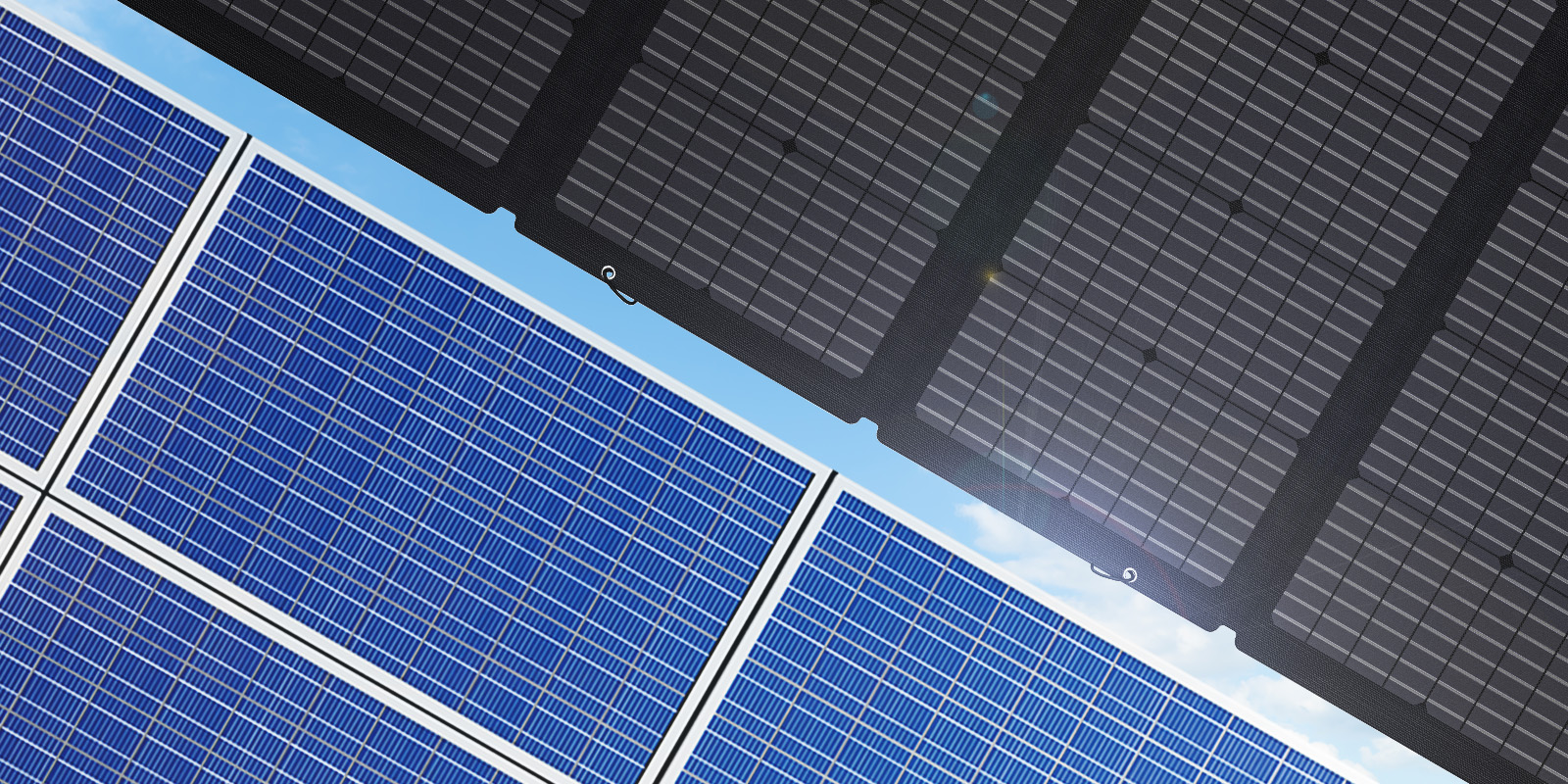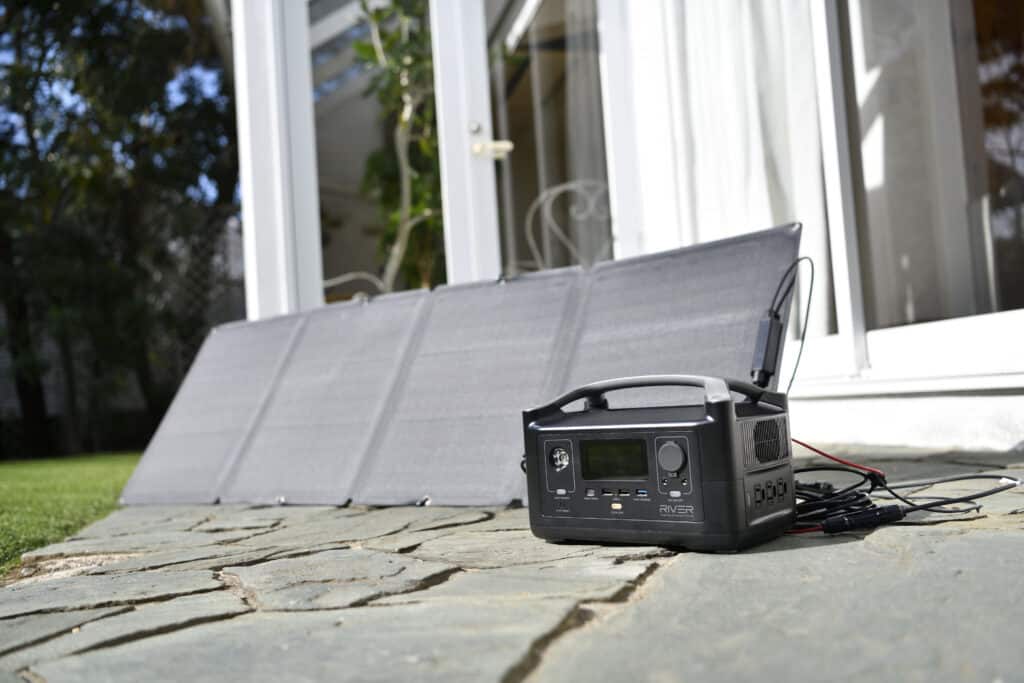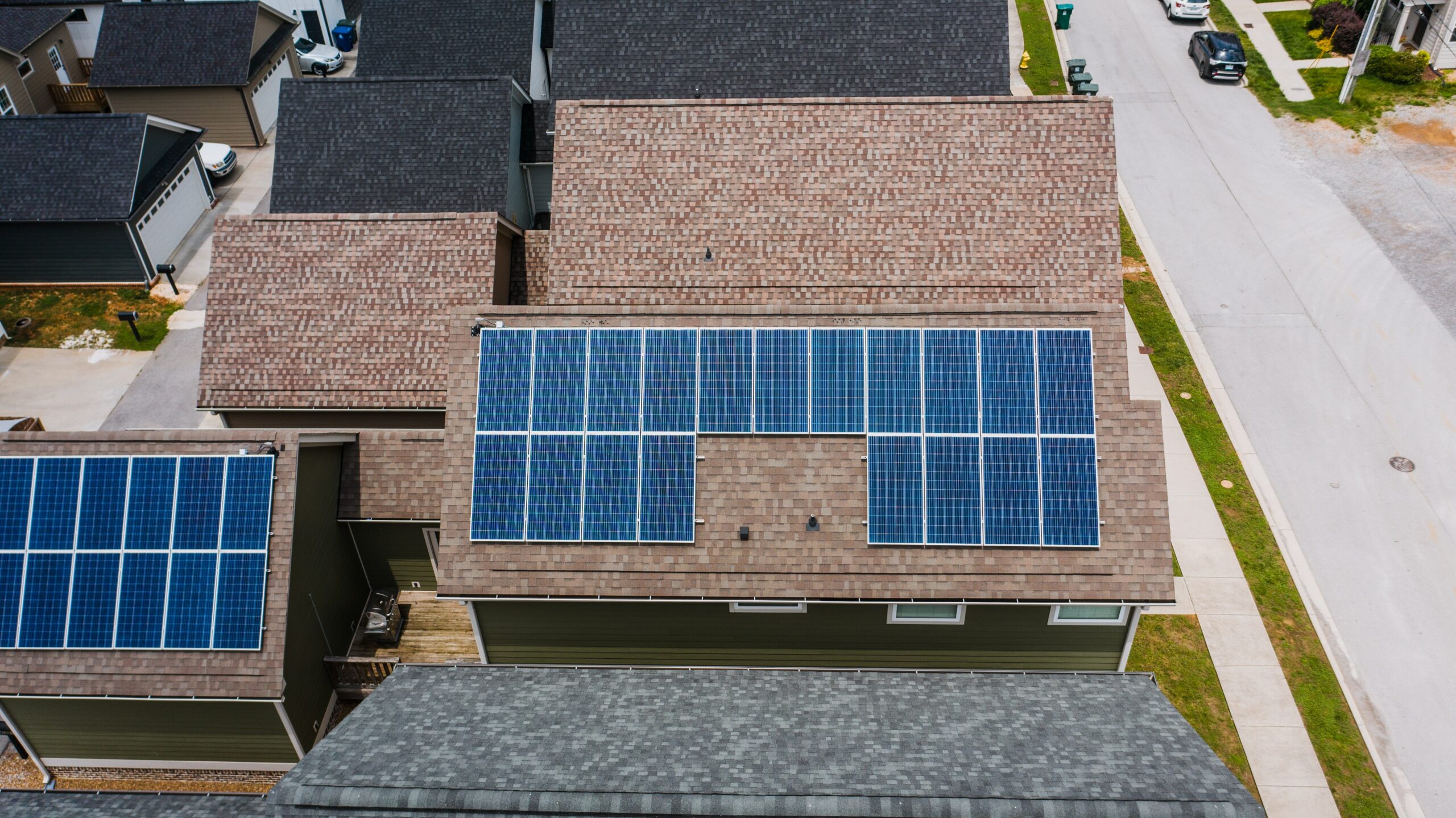On the lookout for some new panels? In this post, we’ll give you a rundown of monocrystalline vs. polycrystalline solar panels. By the end, you’ll know which is right for you. We’ll also recommend a few picks throughout so your new array is worth the pay.

What are monocrystalline solar panels?
Monocrystalline solar panels – as the name suggests – have a single crystal per photovoltaic cell. This is down to a manufacturing process in which a single crystal of silicon is grown and processed into an ingot, which is then melted down, poured into a mold, and separated into wafers which form the monocrystalline modules. You can tell a monocrystalline panel by its black color, uniform texture, and rounded edges per cell.
Why is a single crystal cell design superior?
By having a single crystal per cell rather than many, monocrystalline solar panels have a few advantages. This cell design allows for a larger surface area that can capture sunlight, which means more efficiency per square meter. Pretty handy when you’re short for space. As a result of this, they also perform better in hot environments and work better in sub-optimal coverage, such as shaded areas.
In a nutshell, a single-crystal solar cell = more efficiency and less space needed.
What are polycrystalline solar panels?
Polycrystalline solar cells on the other hand are not made up of a single silicon cell, they’re made up of many, hence the name poly. Unlike monocrystalline panels, multiple crystals of silicon are melded together in the manufacturing process to form the solar cells, resulting in the end product taking up more space and sacrificing efficiency.
Do polycrystalline panels have any advantages?
The redeeming quality of the polycrystalline pick is the manufacturing costs. The process is faster and cheaper due to mega factories’ highly-efficient processes and solar farm orders allowing for economies of scale. In layman’s terms, the cost of production has plummeted. Although we can’t expect this to continue to the same degree due to diminishing returns in savings, it does mean polycrystalline panels are cheaper than ever.

What is the difference between monocrystalline and polycrystalline solar panels?
With the production methods out of the way, we can take a dive into the things that make these two types of panels different. We’ll compare efficiency, cost, portability, durability, and finally aesthetics. Everyone wants a sleek-looking array, right?
Solar Efficiency
The efficiency of a solar panel is measured by its power output per square meter, which is called its “efficiency rating”. Monocrystalline, as alluded to earlier wins out here. Polycrystalline averages roughly 13-16%, with monocrystalline panels topping out just over 20%. This means that they can produce more electricity with the same amount of sunlight.
Winner: Monocrystalline Panels
Solar Panel Cost
Due to the production methods we’ve already covered above, polycrystalline wins out on the solar panel cost. For a 200W panel, you can expect around $200-300. That being said, EcoFlow 160W monocrystalline model balances price and functionality, being foldable, weatherproof, and coming with a carry bag for just $349.99 while they’re on sale now.
Winner: Polycrystalline Panels
Solar Panel Portability
If you need to move your panels around a bunch, such as for camping, RV, or outdoor use, portability is king. Monocrystalline panels have a much higher efficiency per cell, which means you need fewer panels to produce the same amount of energy.
Winner: Monocrystalline Panels.
Solar Panel Durability
While both kinds are durable, it’s worth mentioning if you’re looking for a portable solar panel, it needs to be able to take a beating. EcoFlow are foldable solar panels, slightly flexible, and weatherproof. In fact, you can even dunk them underwater for 30 minutes and they’ll be fine. Safe to say they’re ideal for taking on trips.

Winner: EcoFlow Monocrystalline Solar Panels
Solar Panel Aesthetics
While this comes down to personal preference, the blue tone of polycrystalline panels and their marbled appearance make them stand out more. Monocrystalline panels are black and have a uniform texture, so they blend in better. If you’re looking for a sleek, less intrusive appearance, monocrystalline will be your go-to.
Winner: No Clear Winner
Temperature Coefficient
Monocrystalline panels tend to outperform polycrystalline ones in efficiency as well as regarding temperature coefficient. If you’re unsure what that is, it measures how well a panel performs in hot temperatures above the standard condition of 77ºF (25ºC). The closer the rate is to zero, the better it performs.
Polycrystalline panels typically have a higher temperature coefficient (-0.3%/ Cº to -1%/ºC) than monocrystalline, making them less productive in hot temperatures. Monocrystalline panels aren’t as impacted by the heat, so their temperature coefficient is closer to zero (-0.3%/ Cº to -0.5%/ºC).
These figures mean that polycrystalline solar panels typically reduce more power generation for every degree in Celsius that the temperature increases over 25ºC (77ºF) than their monocrystalline counterparts.
Winner: Monocrystalline
Lifespan
Both monocrystalline and polycrystalline options are made with silicon cells, and the type of cell used has little effect on the panels’ lifespan. That means both options have around a 25-30 year lifespan, though mono options can last longer (30-40 years) with excellent upkeep.
That being said, this difference can be negligible, so know that buying poly panels can still be a reliable option if you prioritize a low initial installation cost. However, monocrystalline panels can sometimes last a bit longer, so if you’re calculating your long-term costs, mono options are still a better option in that sense.
When considering the lifespan of solar panels, it’s a good idea to compare the warranties offered for different products to help you make your decision.
Winner: No clear winner
Mono vs. Poly Solar Panel Feature Comparison
| EcoFlow Monocrystalline Solar Panels | Standard Polycrystalline Solar Panels | |
| Efficiency | 22% | 13—16% |
| Portability | Foldable. Comes with a carry case. | Rigid, bulky |
| Price | Higher | Lower |
| Durability | Waterproof, durable, slightly flexible. | Tough, rigid. |
| Aesthetics | Black, minimalistic | Blue, non-uniform |
Application Comparison: Which type of panel is best for me?
Best solar panels for camping & trips
If you’re heading camping, off on a road trip, or are generally using solar power on the go, a portable solar panel is essential. It means less to pack and less to carry. Your back will thank you later. Efficiency is also a key consideration since you can’t guarantee optimal sunlight or shadow conditions. Monocrystalline are lighter, can be smaller and also perform better in hot environments.
Foldable monocrystalline panels that come with a carry bag would be an excellent pick here.

Best solar panels for home backup
If you have a solar generator for home backup, we’d recommend opting for a monocrystalline panel. It offers more flexibility, giving you a faster charging time with less space if the grid is down. They’re also more portable which makes your life a little easier when setting them up in your garden.

Best solar panels for rooftops
If you’re using a more permanent setup on your roof, then portability is likely not as important to you, for that reason you might consider polycrystalline to save on costs. However, you would be sacrificing efficiency, meaning you’re getting less power from the same amount of space used. You’d also be sacrificing the clean, less intrusive appearance of monocrystalline. Small spaces might still favor monocrystalline rigid solar panels here, and looks might swing the balance. You can weigh up cost vs. efficiency and appearance to decide which type of panel you opt for.

Application solar panel comparison
| Best solar panel for camping | Best solar panel for home backup | Best solar panel for rooftops | |
| Monocrystalline | ✓ | ✓ | ✓ |
| Polycrystalline | ✓ |
Other Factors to Consider When Choosing Solar Panels
Now that you know where these two options fall in terms of important factors like durability and efficiency, you can also consider what personal factors may influence the decision. Don’t forget to account for things like any space constraints you have at your location and your preferences.
Space Constraints
Space constraints may dictate what kind of solar array you can install. While polycrystalline can save a bit on initial installation costs, they take up much more room than mono panels.
If the footprint of your home or building is relatively small, or you don’t have much space on your roof, you may not be able to install the number of panels you’d need to run your home or desired appliances and devices efficiently. Additionally, if you plan to use portable solar panels, you may be limited in car or RV space to store them.If space constraints are an issue, choosing mono options will ensure you maximize your available space and make the most of your solar power system.
Personal Preferences
Don’t forget to consider your preference! For example, some people prefer the look of mono options as they look more streamlined, while poly arrays have a checkerboard appearance.
Frequently Asked Questions
Polycrystalline solar panels take up more room, don’t perform as well in hot environments, aren’t as ideal if you need to move them around a lot, and don’t run as efficiently as monocrystalline panels – so even though they have a lower initial cost, they’re still less cost-effective over their lifetime of use.
Final Thoughts
When comparing monocrystalline vs. polycrystalline solar panels, monocrystalline panels are superior in regards to portability and efficiency, with polycrystalline panels winning out when it comes to initial cost – though the increased efficiency of monocrystalline panels will mean more savings on electricity costs over time.
Investing in monocrystalline panels pays off in the long run, as the only real advantage of poly panels is a lower product cost. Not only will your panels run more efficiently, but they’ll also perform better in hot weather and be easier to take with you due to their smaller size. Consider all this and things like lifespan, durability, aesthetics, size constraints, and even personal preference to determine the best solar panel fit for you.
At EcoFlow, we offer a wide range of monocrystalline solar panels to fit your needs. They come in several sizes so that you can pick the correct wattage for your needs, and we also offer rigid, portable, and flexible options so you can find your perfect fit. Check out our selection today!
